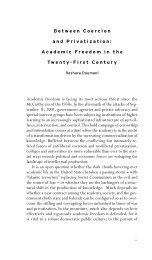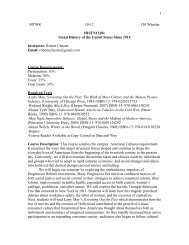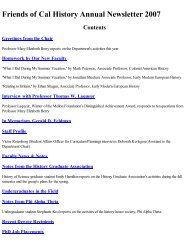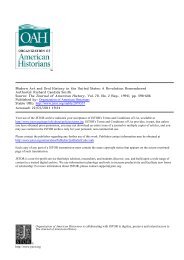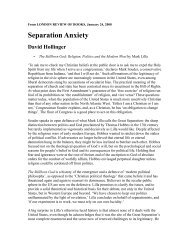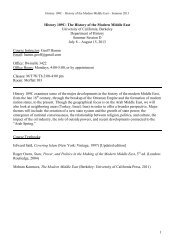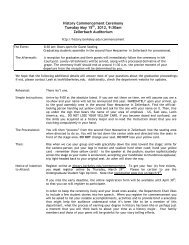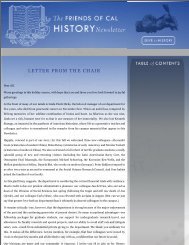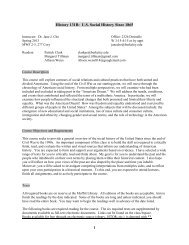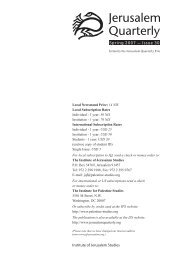David A. Hollinger | Amalgamation and Hypodescent: The Question ...
David A. Hollinger | Amalgamation and Hypodescent: The Question ...
David A. Hollinger | Amalgamation and Hypodescent: The Question ...
Create successful ePaper yourself
Turn your PDF publications into a flip-book with our unique Google optimized e-Paper software.
warning against it. But in 1863, the very year emancipation made mixture more possible,"amalgamation" was replaced by the more ominous word that rang more like "mistaken mixture," <strong>and</strong>under circumstances not so different from those that surrounded Arendt nearly a century later. In anepisode familiar to specialists in U.S. history but known to few other people today, Miscegenation wasthe title of an anonymous tract widely distributed in the North late in 1863 calling on the RepublicanParty to embrace the cause of race-mixing <strong>and</strong> make it the basis for that party's campaign of thefollowing year. <strong>The</strong> tract was a hoax, written <strong>and</strong> distributed by two proslavery journalists who hopedto push the Republicans into endorsing this manifestly unpopular idea <strong>and</strong> thus to be more likely to losethe election to the Democrats. As Sidney Kaplan has demonstrated, the abolitionists themselves weresuspicious from the start. 11 <strong>The</strong> abolitionists did not know the tract was a hoax until after the election,when Abraham Lincoln's success rendered the revelation of the hoax a minor footnote to the campaign.But all during the campaign, the Republicans apparently felt about the anonymous author much thesame way liberals of 1958 felt about Arendt.Eventually, miscegenation would become an ostensibly neutral word, 12 but one that flourished in a 11Jim Crow discourse alongside another term that came into use for the mixing of white Americans witheach other. This was the notion of the "melting pot." It had been around since the earliest years of theRepublic, but it gained currency at the start of the twentieth century in relation to massive immigrationfrom Eastern <strong>and</strong> Southern Europe. This problematic figure of speech was used primarily to address theprospects for the incorporation of these predominantly Italian, Jewish, <strong>and</strong> Polish immigrants <strong>and</strong> theirdescendants, <strong>and</strong> not simply as ethnic groups within a plural society but as individuals who would as amatter of course intermarry with the British <strong>and</strong> other Northwestern European stocks. What made theterm problematic was an ambiguity analyzed by Philip Gleason <strong>and</strong> others. Was the idea to melt downthe immigrants <strong>and</strong> to then pour the resulting, formless liquid into preexisting cultural <strong>and</strong> social moldsmodeled on Anglo-Protestants like Henry Ford <strong>and</strong> Woodrow Wilson, or was the idea instead thateveryone, Mayflower descendants <strong>and</strong> Sicilians <strong>and</strong> Irish <strong>and</strong> Ashkenazi <strong>and</strong> Slovaks, would actchemically upon each other so that all would be changed, <strong>and</strong> a new compound would emerge? 13Although both versions of the melting pot had their champions <strong>and</strong> their critics—<strong>and</strong> of course 12there were strong voices against both, preferring to keep out altogether any immigrants who were not"Nordic"—very few of the early twentieth-century discussants of the melting pot even mentionedblacks, for whom mixing with whites was "miscegenation." 14 Yet when Ralph Waldo Emerson hadspoken before the Civil War about an American "smelting pot"—a slightly different figure of speechassociated originally with the concept of amalgamation—he had explicitly included "Africans <strong>and</strong>Polynesians" in addition to "all the European tribes." 15 Not that Emerson's welcoming of people of allcolors <strong>and</strong> from all continents was shared by that many of his white contemporaries. Quite the contrary.Emerson here spoke for a tiny minority. But he spoke in the idiom of melting, or smelting, before thevocabulary had changed. As the new word—miscegenation—became associated with black-whitemixing, a preoccupation of the years after the Civil War, the residual European immigrant aspect of thequestion came to be more than ever a thing apart, discussed all the more easily without any reference tothe African-American aspect of the question. This separation of mixture talk into two discoursesfacilitated, <strong>and</strong> was in turn reinforced by, the process Matthew Frye Jacobson has detailed wherebyEuropean immigrant groups became less ambiguously white by becoming more <strong>and</strong> more definitively"not black." 16 <strong>The</strong> Jim Crow era featured not only separate schools <strong>and</strong> public accommodations inmany states but also separate <strong>and</strong> invidious national vocabularies for talking about mixture.<strong>The</strong> two vocabularies reflected the two historical conditions that make the United States the North 13Atlantic West's most dynamic site for dealing with our question. First, the United States operated underone of the few constitutional regimes in that domain that had tolerated slavery as recently as the 1860s<strong>and</strong> as a result had a national population a significant segment of which—about 12 percent during mostof the twentieth century—was color-marked as once having been pieces of property or as being the



